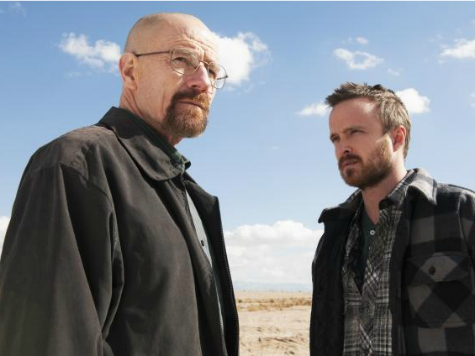By FRAZIER MOORE
AP Television
NEW YORK
The supply is running low and you know there won’t be more. “Breaking Bad” stands to leave its fans reeling.
For five seasons of wickedness, this AMC drama has set viewers face-to-face with the repellent but irresistible Walter White and the dark world he embraced as he spiraled into evil. With the end imminent (Sunday at 9 p.m. EDT), who can say what fate awaits this teacher-turned-drug-lord for the havoc he has wreaked on everyone around him.
This is more than the end of a TV series. It’s a cultural moment, arriving as the show has logged record ratings, bagged a best-drama Emmy and even scored this week’s cover of The New Yorker magazine.
Up through the penultimate episode, “Breaking Bad” has been as potent and pure as the “blue sky” crystal meth Walter cooked with such skill. Judging from that consistency in storytelling and in performances by such stars as Bryan Cranston (Walter White), Aaron Paul (his sidekick Jesse Pinkman), Anna Gunn (who just won an Emmy as Walt’s wife) and Betsy Brandt, the end will likely pack unforgiving potency.
But one thing is dead sure: It will be beautiful.
The action is centered in Albuquerque, N.M., which invites sprawling desert shots and tidy manicured neighborhoods, washes of light and jagged sun-drenched expanses.
The look of the show makes the most of its setting and the technology by which viewers see it: In an age of digital video, with the smallest detail and the sharpest resolution visible to the audience, Walter’s battered mobile meth lab could be clearly discerned as a speck against a vista of deserts and mountains. A doll’s disembodied eyeball bobbing in a swimming pool had chilling vividness.
And don’t forget the show’s visual signature: “Breaking Bad” was never afraid of the dark.
Slovis recalls how, his first week as DP, he was shooting in Jesse’s basement.
The imagery of “Breaking Bad” is second-nature to its viewers, regardless of whether they are conscious of Slovis’ work. So when they swoon at the beauty of the desert outside Albuquerque, they may not know the complexion of this badlands was created in his camera.
You would have a hard time finding many stylistic links between “Breaking Bad” and some of Slovis’ other credits, which include “CSI” (for which he won an Emmy), “Fringe,” AMC’s short-lived noir thriller “Rubicon” and lighter fare including “Running Wilde” and “Royal Pains.” (Nor his additional credits as a director, which range from four episodes of “Breaking Bad” to “Chicago Fire” and “30 Rock.”)
Instead, he said he strives to let each project suggest its own look.
Now 58, Slovis is soft-voiced and lanky, with a head whose baldness rivals Walt White’s in Heisenberg mode.
He got the photography bug while growing up in Plainview, N.J., where he became the school photographer and won a state photography contest. He was invited to study at the Rochester Institute of Technology.
He imagined himself a fine-arts photographer, but he loved movies and storytelling, and, after graduate school at New York University, he landed jobs shooting music videos and commercials, then got nibbles from feature films.
But in 2001, he found movie offers drying up, and, though he had never seen TV in his future, he gratefully accepted a call from the NBC series “Ed.”
The timing was terrific. For decades, TV’s hasty, assembly-line production schedule proved an obstacle to giving a series its own visual style.
Slovis hails pioneering exceptions such as “Twin Peaks,” “Law & Order” and “The X-Files” and credits “CSI” as “one of the first times that cinematography became a real character on a show. TV began changing around us.”
Gilligan agreed that “the advent of flat-screen TV really allowed Michael’s work to shine in a way it wouldn’t have 20 years ago.”
Now the end of “Breaking Bad” is nigh. But through Sunday’s final fade-out, Slovis’ influence will remain, capturing the “Bad” times you can’t turn your eyes from. He’s a series star who’s out of sight, yet controlling what you see.
___
Online:
http:// www.amctv.com
___
EDITOR’S NOTE _ Frazier Moore is a national television columnist for The Associated Press. He can be reached at fmoore(at)ap.org and at http://www.twitter.com/tvfrazier.

COMMENTS
Please let us know if you're having issues with commenting.